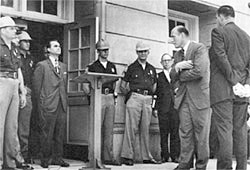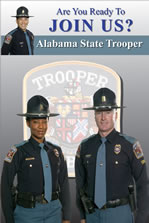
WHY STATE TROOPERS SHOULDN'T DRESS UP IN KKK OUTFITS

The University of Alabama
Gov. George Wallace blocks the doorway to Foster Auditorium at the University of Alabama in Tuscaloosa, June 11, 1963.
Alabama State Troopers "protecting" the University from Federal Court order to desegregate.


The Selma to Montgomery marches, which included Bloody Sunday, were three marches that marked the political and emotional peak of the American civil rights movement. They were the culmination of the voting rights movement in Selma, Alabama, launched by Amelia Boynton Robinson and her husband. Robinson brought many prominent leaders of the American Civil Rights Movement to Selma, including Dr. Martin Luther King, Jr., Jim Bevel and Hosea Williams. "Bloody Sunday" occurred on March 7, 1965, when 600 civil rights marchers were attacked by state and local police with billy clubs and tear gas. Only the third, and last, march successfully made it into Montgomery, Alabama. The route is memorialized as the Selma to Montgomery National Historic Trail. State troopers and the Dallas County Sheriff's Department, some mounted on horseback, awaited them. In the presence of the news media, the lawmen attacked the peaceful demonstrators with billy clubs, tear gas, and bull whips.

TAKEN FROM THE ALABAMA STATE PATROL WEBSITE TODAY (APRIL 17, 2008)
Maybe the Ohio Troopers involved in this episode are too young to remember, but it was not unusual for law enforcement agencies to enforce laws (determined to be unconstitutional) in denying rights to individuals and groups during the civil rights period of the 1960's. The "joke" was a visual reminder of the type of activity that went on for many years which most of us thought we had put well behind us today. Regardless of their lack of memory, why a "hate" group would be the object of their shenanigans during working hours escapes a lot of people.
This is my story:
When I was in 6th grade, I lived on Homestead Air Force Base, south of Miami, in
Florida. This was in 1963.
I was 12 years old going on 13.
My best friend was a black boy named Melvin White. Melvin had 2 brothers and
they lived 3 houses down from me on the base. If you don't know, the United
States Air Force was way ahead of the other branches of the military in
integrating blacks into the mainstream on base, even in southern bases.
The elementary school I attended was mostly for Air Force kids (we were called
"Air Force Brats") and was just outside the Air Base, within walking distance.
There were some civilian kids who went there to, but not many. Melvin and I went
to school there.
After 6th grade, I would be entering 7th grade and Junior High School. At that
time, Junior High School was 7th through 9th Grade in Florida. It was a
different school, and I would be bussed to attend.
I was so excited to go to Junior High School. This school was off-base and was a
regular school in the area and it was called Redland Junior High School (which
was located in Redland, Florida). Instead of Air Force kids, it would have more
civilian kids and was a regular school in the area. Instead of having one
teacher for all of your classes all day, you would go to school, have home room
and immediately go to your other classes with a different teacher for each
subject.
Instead of recess, we would have Physical Education (P.E.) for one hour each day
which meant we would change clothes and actually do physical exercises and
sports for an hour. We would shower after P.E. because we were now old enough
and quite frankly, needed to, because we were stinky kids after working out.
It was basically a transition from being a boy to becoming a man.
In the summer between 6th and 7th grade, my parents and I were talking about my
new school and they told me that Melvin would not be going to school with me
anymore. I couldn't believe it: my best friend wasn't going to school with me
anymore. I asked them why Melvin wouldn't be going to my same school but I
really didn't get an answer except he would have his own school to go to which
was different then mine. I was told I could still play with him after school.
If you remember being 12 and finding out your best friend wasn't going to your
same school (or moving) you would know how I felt. If you have ever lost a good
friend or they have moved away, you would know what I mean. I had no idea what
"segregated" schools meant, but that was why Melvin was not going to my school.
It made me sick since I was counting on him being around since there would be so
many kids in my new school I did not know. At least my best friend would be
there, or so I thought. Melvin wasn't moving, he would still live 3 houses down
from me, but he was not going to my same school.
That is why I feel so strongly about how these troopers acted. I assume they
were not born before 1963 and they certainly don't know what it means to loose
your best friend for the same reason I did. Unfortunately, being 12 going on 13
you become aware very quickly why these things happen. It was a very ugly
feeling.
Whether it's Ohio State Troopers acting like jerks; or Pastor Wright condemning
white people; the feeling inside me is just the same: Why are people so hateful?
The 1960's were great years and terrible years: John Kennedy, Martin Luther
King, landing on the moon, Bobby Kennedy, Viet Nam war, the Beatles and Rolling
Stones, etc. but also the deaths of many, racial riots, peace marches, etc.
So quit writing me and telling me I am being irresponsible in allowing some of
the things that have been written on my website. Or some of the pages I have
written. That this whole episode is being way overblown.
Tell that to Melvin and his brothers and to a twelve year old boy who lost his
best friend.
Frank Caltrider